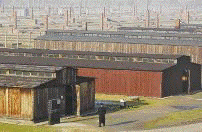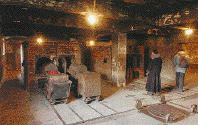Auschwitz Remains Emblem of Evil
By
Vanessa Gera
Associated Press
Published January 23, 2005
Oswiecim, Poland --
At first the red-brick barracks look almost respectable,
numbered like normal houses along tree-lined paths. But
then the gas chamber reveals itself through the wintry
fog, and the death wall where prisoners were stripped and
shot, and the soil and ponds still full of teeth and
crumbled bones from incinerated corpses.
The death factory
where the Nazis murdered 1.5 million people went idle 60
years ago Thursday, but Auschwitz, ground zero of human
savagery, still has the power to stun its visitors into
silence.
"For me, this is a
grave, not a museum," said Shalom Gross, a 57-year-old
Israeli who lost more than 80 relatives to the Holocaust
on his mother's side alone.
He held three
Hebrew holy books. "I have come here to pray," he
said.

|
..
|
|
A
visitor walks past barracks at
Auschwitz-Birkenau in Oswiecim, Poland. Thursday
will mark the 60th anniversary of the camp's
demise, an important milestone since few
survivors will likely live to the
70th.
|

|
|
Visitors
look at the crematorium in Auschwitz. An
estimated 600,000 people visit the death camp
site each year to learn or to grieve. Most move
about the complex quietly, in a spirit of
reverence.
|

|
|
Belongings
of prisoners at Auschwitz are shown in Oswiecim,
Poland. "For me, this is a grave, not a museum,"
said an Israeli visitor who lost more than 80
relatives to the Holocaust.
|
|
Photos:
Czarek Sokolowski (AP)
|
Auschwitz today is many things at once: an emblem of
evil, a site of historical remembrance, a vast cemetery.
With its neighbor Birkenau and the town of Oswiecim
&emdash; the Polish name of Auschwitz &emdash; it is also
a place where life goes on, where people go to work, shop
for groceries and try to make a living in a depressed
coal-mining region where unemployment runs to 19
percent.
Some of the
barracks serve as offices for the scholars and
administrators at the memorial site, who walk past the
gas chamber and barbed wire as they go to and from work.
A room once occupied by an SS guard is eerily preserved,
down to the photo of Adolf Hitler on the wall.
"It is strange to
work here, where we don't have contact with beauty," said
Franciszek Piper, the head of the museum's historical
research department, whose spare office is on the second
floor of Block 23. "But if people in Poland wished to
live far from the places where people were killed,
persecuted, where the soil is soaked with the blood of
those killed by the Nazis, then everyone would have to
leave Poland."
The 60th
anniversary carries special weight, because very few
survivors are likely to be alive for the 70th. Vice
President Dick Cheney will attend Thursday's ceremony at
Auschwitz along with Presidents Vladimir Putin of Russia
and Jacques Chirac of France and others. President Bush
visited Auschwitz in 2003.
An estimated
600,000 people visit the camp each year to learn or to
grieve or to reflect on the past. Most move about in
quiet reverence, yet even here, there's occasional levity
&emdash; smiling tourists posing under the infamous main
gate with its cynical slogan "ARBEIT MACHT FREI" (work
makes you free), or a group of visitors laughing as they
line up to see a documentary about mass
murder.
Poland's chief
rabbi, Michael Schudrich, says he has often seen such
behavior at Auschwitz.
"It's exactly the
people who are smiling that you want there," he said.
"While it's disconcerting to see, the experience will
play back in their heads -- two months or two years later
-- and have an effect."
More than 90
percent of the victims from 1940 until the Soviet Army
liberated the camp on Jan. 27, 1945, were Jews, and the
rest were Gypsies, Polish political opponents, Soviet
POWs, Catholics and homosexuals. They died in gas
chambers, from starvation, medical experiments, disease
or forced labor.
Auschwitz is in
fact not one camp, but two: Auschwitz I, built in an
abandoned Polish military base, and Auschwitz II, or
Birkenau, a much bigger complex that went up later about
two miles away to expedite the Nazis' Final
Solution.
It is Birkenau that
shocks more profoundly, a flat, vast space still ringed
by the silver birch trees (birken in German) that gave
the place its name. Crematoria lie in rubble as a
reminder of the Nazis' effort to hide their crimes as
defeat loomed. Still intact are the rail tracks on which
prisoners in cramped cattle cars were hauled into the
camp and selected for slave labor, experiments or
death.
Many of the
visitors are Israeli schoolchildren brought here to
reinforce the ethos of "never again." Many more come from
Germany, alone or in groups organized by schools,
churches and unions to confront their nation's
past.
This month, a
German service workers' union brought adults to visit the
camp and meet with a survivor.
After a day at the
camp, they gathered to reflect.
"I cannot
comprehend the cruelty, how our parents and grandparents
could have gone along with this," said Jochen Schuk. "Or
even today how people can still cling to ideologies of
hatred."
Auschwitz is held
up as a moral lesson in the fight against racism and
anti-Semitism, but it has also become a potent symbol for
those seeking other meanings.
For Poland, invaded
and occupied for five years by Germany, then ruled by
communist dictatorship for more than 40 years, having
Auschwitz on its soil is particularly painful. The Nazis
treated the Poles as an inferior race, dotted their land
with death camps and murdered about 3 million non-Jewish
Poles. Yet it often is tainted with guilt by
geography.
So sensitive is
Poland to accusations of anti-Semitism that visitors to
Auschwitz are forbidden to make recordings of guided
tours. Some have edited the recordings to "prove that
Poles are anti-Semites, even those who work at the
Auschwitz museum," said Marzena Konopka-Klus, a camp
guide.
A particularly
fraught question is whether Auschwitz is primarily a
Jewish experience, or a universal one.
One of the most
wrenching disputes involved a Carmelite nunnery next to
the camp. Jewish groups protested that it was an
intrusion on their sacred burial place. Polish-born Pope
John Paul II intervened in 1993 and got the nuns to move
out.
Jews and Christians
have quarreled over crosses put up around Auschwitz. A
discotheque in a tannery near the camp where prisoners
worked and died was shut following international
protests. Plans for a small shopping mall across the
street from the Auschwitz museum were also scaled down
after Jewish groups complained.
And then there's
the predicament of Oswiecim, a town of 42,000 forever
associated with a monstrosity for which it bears no
blame.
Residents insist
that life in Oswiecim is just as normal as anywhere else.
But Andrzej Bibrzycki, the chief elected county official,
said he longs for a time when investors and tourists will
stop shunning the economically depressed coal-mining
area.
"In Jerusalem, near
Christ's tomb, Muslims are doing good business. So
believers of other faiths are making good money near
sacred shrines," he said. "I think these kinds of
expectations are normal."
At this time of
year, tourists move through the camp and the unheated
exhibit spaces bundled in heavy coats. Any urge to
complain is stifled by the photos of inmates in thin,
pajama-like fatigues.
As dusk falls,
museum officials quietly lock the entrance gates, but
refrain from breaking the silence with announcements over
loudspeakers. As the night deepens, the visitors drift
off at the time of their choosing &emdash; or when the
gloom and cold become unbearable.
